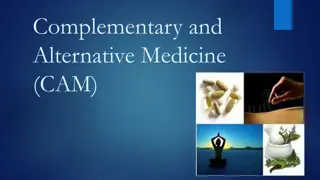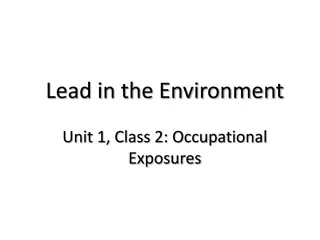Evolution of Occupational and Environmental Medicine Physicians
Over the past century, Occupational and Environmental Medicine (OEM) physicians have played a crucial role in identifying and addressing occupational hazards. From the historical significance of occupational diseases to the development of specialized training programs, this field has evolved significantly. The focus has shifted towards environmental aspects, such as nanotechnology and aerospace hazards, highlighting the importance of collaboration with various stakeholders. The history of OEM physicians reflects the advancements in medical education and the establishment of professional associations, paving the way for a more informed approach to workplace health and safety.
Download Presentation

Please find below an Image/Link to download the presentation.
The content on the website is provided AS IS for your information and personal use only. It may not be sold, licensed, or shared on other websites without obtaining consent from the author. Download presentation by click this link. If you encounter any issues during the download, it is possible that the publisher has removed the file from their server.
E N D
Presentation Transcript
Fundamentals of Industrial Hygiene 6thEdition Chapter 26: Occupational and Environmental Medicine Physician Compiled by Janvier Gasana Associate Professor, Environmental & Occupational Health Florida International University
Focus of Occupational Medicine In the past decade, focus increased on environmental aspect of preventive medicine specialty New challenges nanotechnology hazards aerospace and undersea environments Maintain partnership with government, industry, and labor scientists in ongoing evaluation of hazards in industrial operations What is in workplace gets into air, soil, water, and into our bodies via food and drinks
History of OEM Physician From very early days physicians have noted the importance of occupation in causation of disease and injury Bernardino Ramazzini s three causes for upper extremity cumulative trauma disorders: 1. constant sitting 2. incessant movement of the hand in the same direction 3. lack of benefits of moderate exercise
History of OEM Physician (cont.) In late 1800s, states required medical school degrees American Medical Association (AMA) founded in 1846 Council on Medical Education issued Flexner Report in 1910 criticizing 131 medical schools 70 survived Innovations helped U.S. move from agricultural society to industrial society anesthesia use, aseptic technique, diagnostic instruments and tests, identification of disease-causing organisms, and development of vaccines In 1860s, railroads and mining companies employed physicians to treat victims of industrial accidents Workers compensation laws did not exist until early 1900s
History of OEM Physician (cont.) ACOM (American College of Occupational Medicine) now known as the American College of Occupational and Environmental Medicine (ACOEM) More than 30 occupational medicine residency programs were developed at major universities across the United States Approximately 75 physicians per year Fiscal crises caused number of programs to drop to 28 Over 4,000 doctors are members of ACOEM Approximately 1,500 members are board-certified as specialists, more than half approaching retirement age
Credentials and Professional Associations Since 1984, all physicians graduating medical school required to complete residency or fellowship program to become eligible to take Occupational Medicine Board Exam 2-year program, usually after full or partial residency in another field (e.g., internal medicine) content includes public health training in toxicology, epidemiology, and statistics, and practicum year of clinical, research, corporate placements, public sector agency rotations most academic occupational medicine residency programs focus heavily on toxicology and epidemiology
Credentials and Professional Associations (cont.) OMB Exam offered once a year by American Board of Preventive Medicine 200 300 physicians who take examination annually must demonstrate proficiency both in preventive medicine and occupational medicine to pass. Recertification examination required every 10 years Internet can also be path to MPH degree Part-time residency programs allow qualified physicians to make transition without disrupting personal lives Alternative credentialing being explored because there are not enough qualified practitioners to meet needs of country
Practice Settings Corporate medical department corporate medical directors likely consultants to human resources department medical directors provide medical review for workers compensation cases Other duties may include fitness-for-duty evaluations, development of medical surveillance protocols for occupational exposures, and the establishment of wellness programs. corporate-based OEM physicians or consultants frequently need business and fiscal-management skills and computer skills. physicians working for multinational corporations also need to become experts in travel medicine
Multispecialty Group Practice / Hospital-Based Programs Physician may work in separate occupational medicine department or as subspecialist, usually in division of medicine or family practice, sometimes as part of emergency/urgent care. Usually these positions are primarily clinical, and frequently require heavy patient load of 20 to 30 patients per day. Additional responsibilities may include developing programs to attract local industry (e.g., injury care, pre- placement examinations, wellness efforts, and drug testing) performing consults for colleagues from other departments or divisions on environ-mental exposures or work or disability issues helping to ensure that workers compensation visits are correctly reported and billed
Freestanding Occupational Health Clinics May be single entity or part of chain of clinics developed to serve multiple local companies by providing range of services Sometimes industrial services are combined with urgent care for nonindustrial problems Do not usually have access to specialized services available to hospitals or multispecialty group practice programs Often practitioners are required to see 30 40 patients per day, are not specialists in field, and focus on injury illness treatment and pre-placement and surveillance examinations Many working in these clinics have little time or training to deal with complex health and safety issues
Private Consulting Firms Many academically trained, board-certified occupational medicine physicians chose to join or set up their own consulting firms. Allows a wide range of practice opportunities, including consulting with companies, local government agencies, and unions performing medical surveillance & other examinations acting as expert witnesses doing epidemiological research participating in environmental hazard investigations Frequently these firms have close working relationships with industrial hygienists, epidemiologists, toxicologists, and occupational health nurses
Academic Occupational Medicine Departments These have been established in all of the universities with occupational medicine residency programs and many others, and are growing in numbers Responsibilities in this setting include research and teaching and patient care, consulting, and expert witness testimony. Occupational medicine physicians working in academic settings are board-certified, frequently in occupational medicine and another specialty, and may be allotted additional responsibilities, for example, attending on medicine wards, proctoring medical students, etc.
Environmental Agencies & Nongovernmental Organizations Global environmental crisis has spurred significant growth in activist and scientific environmental organizations with legislative campaigns to forestall and/or clean up hazardous sites, and reduce body burden of industrial chemical contamination through product substitution.
Government Agencies Policy development and regulatory agencies in areas of occupational and environmental health and safety often have one or more staff physicians to provide scientific oversight and backup. NIOSH, federal and state OSHA programs, EPA, and other federal, state, and local governmental agencies have in-house, well-trained, and credentialed occupational and environmental physicians who are significant resources of information for industrial hygiene and safety personnel. All branches of military also have active occupational medicine programs.
International Occupational & Environmental Health Consulting A growing field that is attracting number of board-certified occupational medicine physicians Rapid industrialization in Asia, South America, and some parts of Africa has created significant industrial and environmental problems OHS professionals from U.S., Canada, and Europe are finding jobs as consultants duties range from training of local professionals and conducting epidemiological research studies to consulting on governmental policies and legislation and making presentations at international conferences
Union Occupational Health Physicians OHS has long been an important issue for unions whose members face exposure to significant chemical hazards, and is a growing issue for newer service sector unions, such as Service Employees International Union Union efforts have been key factor in spurring legislation mandating stronger workplace health and safety regulations. Professional medical expertise plays critical role both in creating and supporting such legislation
Scope of Practice Familiar with state and federal workers compensation systems be able to evaluate and treat common work-related injuries/illnesses Able to perform pre-placement, DOT, and basic medical surveillance examinations for respiratory protection/exposure to toxins Board-certified OEM physicians should: Provide expertise and guidance on more complicated toxic and other workplace hazards, including difficult issues regarding causation. Be familiar with important local and national legislative developments, including employment and health- and safety-related issues e.g., Americans with Disabilities Act, status of upcoming bills on hot topics such as ergonomics, changes in workers compensation laws, legislation about medical surveillance requirements, protocol and policy development
Clinical Practice Occupational health history brief occupational health history should be part of all medical histories most physicians still not appropriately trained in how to take good occupational history safety & health professional must rely on referral to specialists in field. most employees find form easy to fill out should be instructed to do so chronologically
Clinical Practice (cont.) In addition to past and current occupational history, form also covers moonlighting jobs and hobbies often source of significant exposures separate from or in addition to those in full-time occupation Questions about reproductive history are also important to occupational history, as effects from certain chemicals and other hazards may present first or only in this area When evaluating specific job, including questions that focus on workstation and work tools, work tasks, and individual s work practices may be useful addition to baseline questions
Clinical Practice (cont.) Drug testing and medical review officer examinations drug testing a major focus for many companies concerned about job safety required as part of pre-placement screening process, and many companies also require employees to agree to testing in event of work injury, or, in sensitive occupations, randomly during course of work year OEM physician can help employers develop useful monitoring program and can also provide medical review officer services to evaluate results of testing if physician is MRO certified certification requires significant additional training and ongoing accrual of annual continuing education points
Workers Compensation Case Evaluation & Treatment Special laws cover federal employees who are injured on job, such as maritime, railroad, and long shore industries OEM physician practicing in specific geographic area should familiarize themselves with both state and national laws relevant to that area Most workers who are injured on job recover and continue working. Psychosocial factors also play major role in 15 20% of cases with delayed recovery























